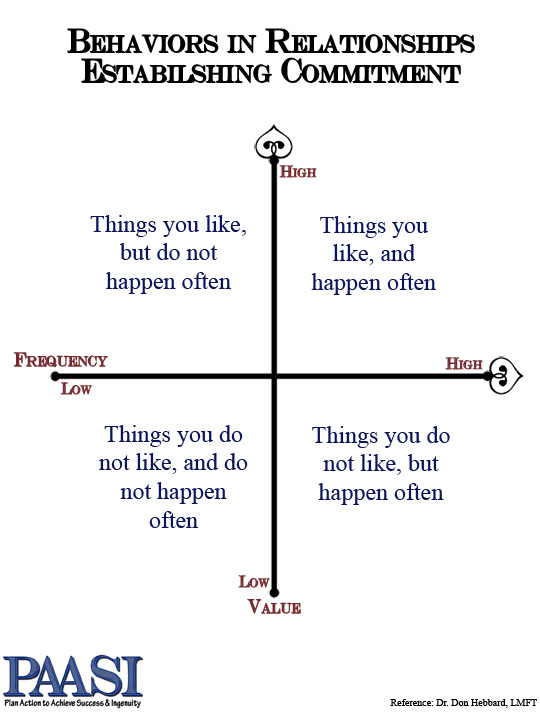In order to build commitment, first you need to understand how your behaviors have been interpreted by your partner. Second, you should talk to your partner about which behaviors your partner interprets as loving actions. Third, you must work to increase the frequency of the loving actions. In the Commitment Building Model, we use two axis to rate the behavior. On the X axis, we determine the frequency in which the behavior occurs. On the Y axis, we determine the value of that behavior, which is set by the partner.

The two axis are perpendicular, and cross in the middle of each axis. Where the two axis meet is equivalent to a neutral feeling, which creates a negative and positive section on each axis and depicts four quadrants. We can place each of our behaviors into one of the four quadrants. The top two quadrants are behaviors that our spouse finds to be positive and loving. The top left quadrant are behaviors that do not happen often, but are pleasing to the partner. The top right quadrant holds the behaviors that the partner views as loving and occur with a high frequency. The bottom two quadrants are behaviors that the partner does not value, and finds to be unloving. The bottom left quadrant are the negative behaviors that do not happen regularly, and are easily ignored or brushed off. The bottom right quadrant are behaviors that happen regularly, yet are undesirable to the partner.
The goal of the Commitment Building Model is to take a look at how our actions and behaviors are affecting our relationship in the eyes of our partner. Once we know what falls into which quadrant, we can begin to make changes to our actions and behaviors in order to move them into the more desirable quadrants. For example, the actions and behaviors that fall into the top left quadrant can be increased in frequency, allowing them to shift into the top right quadrant. The behaviors in the bottom right quadrant can be decreased in frequency to move them into the bottom left quadrant. Couples need to understand that the top right quadrant builds love, commitment, and happiness. The strongest relationships are ones that reside mostly in the top right quadrant.
The weakest relationships reside in the bottom right quadrant. These actions and behaviors are not valued highly, and occur on a regular basis. These actions are similar to a grain of sand in our shoe. Each time they occur, another grain of sand is dropped into our shoe. At first, it seems irrelevant and easily dismissed. However, as time goes on and the grains of sand multiply, that shoe becomes increasingly more uncomfortable and frustrating. Eventually it gets to a point where you cannot walk normally, and a limp takes over our previously smooth stride. The only way to walk normally again is to dump out the sand from that shoe. For many couples, when someone needs to empty the sand from their shoe, divorce becomes an option as a means to a shoe without sand. It is important for couples to identify the actions and behaviors in the bottom right quadrant to either eliminate those behaviors or decrease the frequency so those behaviors can move into the bottom left quadrant.
One way to build up the actions and behaviors in the top right quadrant, which is our strongest and most effective quadrant, is with the Caring Days Procedure. This exercise can be used at any stage of a relationship to build commitment and strength. The first step is for each partner to write down five actions that make them feel loved. These actions have no monetary value, meaning “buy me flowers” is not an acceptable action to be included in the five. The list needs to focus on small, very specific actions, but void of anything that has been the topic of a recent argument. For example, if the couple has recently fought over taking out the trash, then neither should include taking out the trash as one of their action items on the list. Clients may need to be encouraged to think back to the beginning, and remember what the other did for them as they were falling in love. Examples of these actions could include a text message during the day to say they are thinking of the other, picking up the dishes from the table after dinner while the other gets a few minutes to relax on the couch, or simply asking their partner if they need anything when they stand while the other is still sitting. Once each partner has their list of 5 actions they would like for their partner to do, they should exchange their lists for review to ensure they can accomplish them with grace instead of resistance. The last thing you want is for your partner to feel like the tasks are a grain of sand in their shoe. Once you both agree on what makes each person feel loved, begin implementing the requests at an interval of two actions per day. After a week of working with those five actions, each partner should add two more to the list of requests, followed by review before implementation. Every week following, two more actions are added. Eventually, each partner will have a strong list of actionable tasks that they can do to show their love for the other. The more love being exchanged, the stronger their commitment is to each other.
If you want to increase feelings of love and commitment in your relationship, think about the diagram, think about your actions, and have a conversation with your partner. The most important and strongest tool you have is communication. If communication is difficult in your relationship, we have some tools to help! Learn more…
